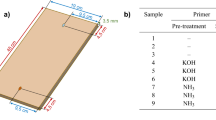Abstract
This study presents three-point bending test results of Norway spruce clear wood specimens loaded on the radial-longitudinal plane in two different load cases. The tested samples were graded as resonance wood for instrument making and were characterised by narrow annual rings and relatively low density. The modulus of elasticity (MOE) and the corresponding modulus of rupture (MOR) are illustrated separately for the samples with straight grain and the group showing the specific growth pattern of indented rings (‘hazel growth’). With the longitudinal wood anatomical direction parallel to span width, the fibre deviation caused by the indents reduces MOE and MOR values, whereas a ‘reinforcing’ effect of the indents could be observed for the load case with span width parallel to the radial direction. Both aspects lead to a reduction in anisotropy for hazel-growth Norway spruce (anisotropy MOE: indented rings 11.6, straight grain 14.7, anisotropy MOR: indented rings 6.9, straight grain 8.9), which partly explains the exceptional position of this growth pattern for the construction of high-class musical instruments with outstanding mechanical and acoustical performance.


Similar content being viewed by others
References
Bariska M (1978) Klangholz, Holzinstrumente, Musik. Naturwissenschaftliche Rundschau 31(2):45–52
Bucur V (2006) Acoustics of wood, 2nd edn. Springer. ISBN 1431–8563. Chap. 7
Buksnowitz C (2006) Resonance wood of Picea abies. (Doctoral Thesis—Institute of Wood Science and Technology Vienna University of Natural Resources and Applied Life Sciences—BOKU Vienna)
Buksnowitz C, Teischinger A, Müller U, Pahler A, Evans R (2007) Resonance wood (Picea abies (L.) Karst.)—evaluation and prediction of violin makers’ quality-grading. J Acoustical Soc Am 121(4):2384–2395
DIN 52 186 (1978) Testing of wood; bending test
Feuerstein A (1935) Das Klangholz. Forstwissenschaftliches Centralblatt 57(19):617–624
Holz D (1984) „Über einige Zusammenhänge zwischen forstlich-biologischen und akustischen Eigenschaften von Klangholz (Resonanzholz),“ („On relations between biological and acoustical properties of resonance wood“). Holztechnol 25(1):31–36
Holz D (1996) Welche Qualitätsparameter von Resonanzholz für den Geigen- und Klavierbau sind relevant? DAGA 1996:310–311
Lev-Yadun S, Aloni R (1991) An experimental method of inducing ‘hazel’ wood in pinus halepensis (pinaceae). IAWA Bull ns 12(4):445–451
Niemz P (1993) Physik des Holzes und der Holzwerkstoffe. DRW-Verlag. ISBN 3-87181-324-9, p 140
Romagnoli M, Bernabei M, Codipietro G (2003) Density variations in spruce wood with indented rings (Picea abies). Holz Roh- Werkst 61:311–312
Sell J (1989) Eigenschaften und Kenngrößen von Holzarten. Baufachverlag AG Lignum Zürich, 3rd edn. ISBN 3-85565-223-6
Treu A, Hapla F (2000) Untersuchung der Qualität von Fichten- und Tannenklangholz. Allgemeine Forst- und Jagdzeitung. 171:215–222
Wagenführ R (1996) Holzatlas. Fachbuchverlag Leipzig. 4th edn. ISBN 3-446-00900-0
Ziegenhals G (1999) „Ermittlung von Auswahlkriterien für Resonanzholz,“ („Selection criteria for resonance wood“), Projekt report—Institute für Musikinstrumentenbau Zwota.“
Ziegler H, Merz W (1961) Der Haselwuchs; Über die Beziehung zwischen unregelmäßigem Dickenwachstum und Markstrahlverteilung. Holz Roh-Werkst 19(1):1–8
Zimmermann U (1996) „Anforderungen an das Klangholz,“ („Requirements for resonance wood“). Schweizer. Zeitschr. f. d. Forstwesen. 9:695–702
Author information
Authors and Affiliations
Corresponding author
Rights and permissions
About this article
Cite this article
Buksnowitz, C., Evans, R., Müller, U. et al. Indented rings (hazel growth) of Norway spruce reduce anisotropy of mechanical properties. Wood Sci Technol 46, 1239–1246 (2012). https://doi.org/10.1007/s00226-012-0480-0
Received:
Published:
Issue Date:
DOI: https://doi.org/10.1007/s00226-012-0480-0




